Sigma 18-250mm f/3.5-6.3 DC OS HSM
Tamron’s 18-250mm lens – later adopted by Sony – was so good that it really takes some effort to beat it. Sigma has put that effort in, but the cost is a very much larger and heavier lens. If all you got was some better performance, it might not be all that exciting. But you get potentially superior anti-shake through its built-in OS, and faster focusing with HSM, the Sigma equivalent of SSM. And you can buy it for under $430, and it works fine on the NEX A-mount adaptor for stabilised videos too – with some degree of autofocus tracking during filming.
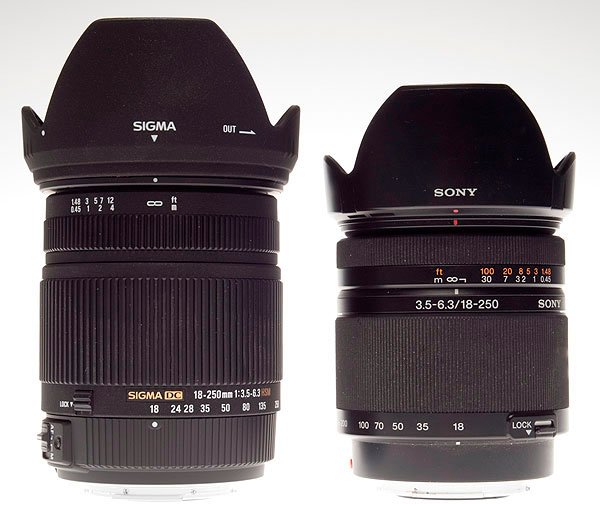
So, here is the size difference. You can see the scruffy Sony rubber grip, but that brand new Sigma with even the a few days’ handling also picks up dirt. You are looking at a lens with a 72mm filter versus 62mm for the Sony, and it feels far bigger in the hand or on the camera. The zoom action is also pretty stiff if the lens is opposing gravity – trying to zoom in while tracking an aircraft or bird in the air above you needs a strong twist, as does zooming back if you are aiming down from a high viewpoint. However, the Sigma on the level has a good feel. I just wonder what time will do to the mechanism. Editor’s note, December 2010: after 18 months of use, it slips like any other zoom – aim downwards and you are at 250mm before you know it. These lenses need a lock which works at any z0om setting not just 18mm! Try shooting a small animal at ground level. Seems no maker has yet devised any zoom like this which stands up to a few months in use without becoming so sloppy it zooms itself.
The zoom lock only works at 18mm, as expected. It is positioned very close to the AF/MF switch which in turn is above the Optical Stabiliser on/off switch. With the camera to the eye, I sometimes operated either one of these when trying to hit the zoom lock release, most often the AF/MF switch.
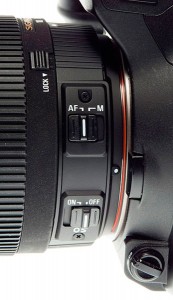
Although the Sigma is HSM, do not confuse this HSM with the version found in the 70-200mm f/2.8 Sigma, or with Sony SSM. The focusing ring moves, to start with, and has no direct manual focus over-ride. To use manual focus you must switch the lens from AF to MF using the lens switch, not the switch on the camera body, or indeed the AF/MF toggle-hold button. All body controls for auto or manual focus are disabled and you can not turn the focus ring on the lens unless you switch to MF on the lens itself.
It is similar in operation to Sony SAM though the HSM motor is in a different class to whatever Sony has chosen put inside their SAM lenses. Focusing is moderate in speed for long travel (a typical HSM thing) but very fast indeed for tiny incremental adjustments. It is quiet as well. I would not swear that the Sigma is faster than the Sony with its mechanical drive, but it is much smoother in use. It certain gives the impression of being faster, and focusing is extremely accurate on our A700, A350 and A380 bodies alike. The focusing ring only needs about one-eighth of a turn from ‘beyond infinity’ to the closest (45cm, 18″) setting. The zoom ring uses a quarter turn and is well marked from 18 to 135mm with focal lengths 18, 24, 28, 35, 50, 80 and 135. Between 135 and 250mm there’s barely 15mm of scale and attempts to set a guessed focal length like 200mm could be wildly inaccurate.
Apertures appear to be f/3.5 until just under 24mm, f/4 from 24 to 35mm, f/4.5 to around 48mm, f/5 from 50mm to 75mm, f/5.6 from 80 to 135mm, and from then on f/6.3. These are not sudden jumps, of course, just the closest the camera can report to a continuous change in maximum aperture. This is a good result, especially at the wide end where having a true f/3.5 from 18mm to 23mm is unusual.
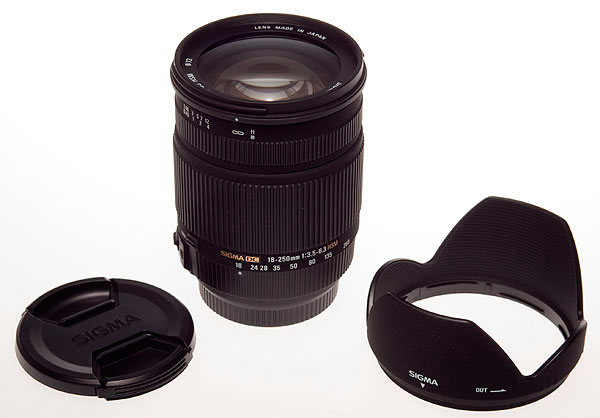
The lens itself comes with a petal hood, good quality front and rear caps, but no case. Why would you need one? This lens, if you buy it, will live on the camera all the time. The lens hood will reverse on to the lens, but should always be fitted properly for shooting. This complex zoom is no more flare-prone than any other, but it does have a very large front element which is not recessed.
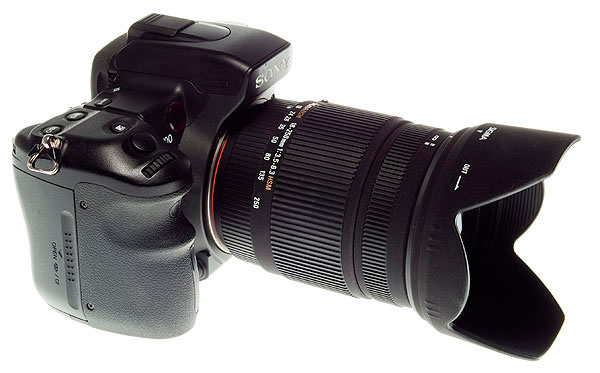
When collapsed to 18mm, ideally locked to prevent zoom creep wearing the mechanism out prematurely, it’s a chunky but reasonably compact lens, comparable in size to the CZ 135mm f/1.8 or 24-70mm f/2.8 zooms for the Alpha system.
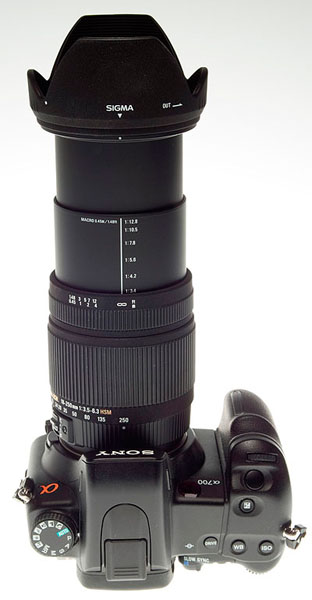
You can see here that even on the Alpha 700 body, not a compact design, the Sigma can also be an impressive weapon – perhaps attracting the wrong attention from security guards, community police, concert and sports venue staff or parents convinced you are the bogey-man or bogey-woman. Extended, it is as large as the Sigma 70-200mm (which does not change size). The double extension is very firm and not wobbly in the slightest – this is a well made lens, very solid with a metal mount.
Lens Construction – 18 Elements in 14 Groups
Angle if View (1.5X Format) – 78.5 – 6.5 degrees
Number of Diaphragm Blades – 7 Blades
Minimum Aperture – f/22 to f/40
Minimum Focusing Distance – 45cm
Maximum Magnification – 1:3.4
Filter Size – 72mm
Dimensions – Diameter 79mm x Length 101mm
Weight – 630g
SRP – £559.99


OK – time has come to decide between new lenses for the A77 that is on order –
Sigma 18-250 OS HSM or Tamron 18-270 Pz motor?
I managed to take some more shots today, did some experimenting with
aperture and ISO settings. Double checked that OS was off and SSS on.
I took a number of pictures in the f8 – 11 range. 18mm, 250mm and a few macro shots. For the macro shots, I tried both manual and Scene/Macro settings, didn’t make any difference that I noticed. I tried the f11-16 range.
I hate to say it, but I am not impressed.
The image quality at low ISO (800 and below) is about the same as my P&S up to about ISO 200; but going to higher f numbers forced me as high as 1600 ISO …in bright daylight. So stopping down the aperture starts to cut into the advantage of the better ISO noise.
Macro IQ is definitely better on the P&S.
I do see some stunning images on the web from this setup, but right now I’m thinking there may be a lot of PP involved. I certainly never came close to “stunning”.
This being a lens review article, I feel a bit guilty bringing the camera body into it, but I can’t really separate out whether it is a limitation of the lens or the body. I concede it may be me, but I sure don’t see what I’m doing wrong.
I really was hoping for better low light performance (got it), more features (got those), and better IQ both in good light(nope) and macro (nope).
I’m pretty disappointed. I did a lot of research and this combination came out as about the best all-round setup I could find. I really wanted it to knock my socks off … but I think it goes back in the box and back to the dealer.
I don’t know whether to bother trying one of the other manufacturers, or whether to give up on the superzoom idea and go to lens swapping.
Or maybe just forget DSLR’s altogether.
Anyway, thanks for your help David. I’m glad the lens/camera works for you, I guess maybe I just had unrealistic expectations.
Thanks for the quick reply and the tips David!
It’s raining here in southern NH/USA so I can’t get out and do test shots right now, but as soon as I can I will and will get back to you.
Your tips about aperture may be the issue; the quick shots I did last night were as wide open as the lens settings would allow; so maybe that’s the problem.
I was using SSS, with the lens OS off. I doubt I can be patient enough for that long wait for the OS to activate !
I hope I can get this IQ straightened out, other than that (which is key of course) I really like the setup.
I guess I’m looking for a sanity check. Never had aDSLR before, just bought a Sony a55 and Sigma 18-250 and am surprised at the relatively poor IQ compared to my Canon Sx120 P&S. I expected IQ to be better in all lighting, but so far (only a few test shots, can’t do many if I want to return it – which I think I do), disappointed.
At high ISO, the a55/Sigma is clearly superior.
At low ISO, outdoor shots in good light, both macro and wide, the Canon P&S IQ is better. Much unexpected!
Is this common, that a P&S IQ be better at low ISO?
Or maybe there is technique I’m missing … maybe just because I’m not at the ‘sweet spot’ aperture for the sigma?
Been shooting at the lowest f-stop possible. Maybe that’s bad?
Reviews for both the a55 and the Sigma are all good … so if this is as good as it gets I guess there’s no point in trying other DSLR / lens combinations 🙁
Clearly something is very wrong as the A55 image quality at low ISO is superb – and the Sigma is the best lens of its type. First of all, the Sigma is generally at its best around f/8 to f/11 on the A55. It will not be capable of good macro shots at 250mm and f/6.3 (wide open is never sensible with any long range zoom) and the depth of field will not be sufficient for many subjects, so for macro work I would always try to use f/11 or even f/16 and move to a higher ISO. It is noise free up to ISO 1600 if processed correctly from raw, and this is very useful for macro. If you try to stop down to say f/16 or f/22 for routine work you’ll just get soft images (diffraction) and probably subject movement at low ISOs.
One thing to be absolutely sure about is the SSS setting and OS on the lens. We use the lens OS, it really helps with viewing at longer lengths. This means the SSS in the camera MUST be set to OFF in the menu. If you leave Steady Shot set to ON, you will get very unsharp images when the Sigma lens is also set to OS, the two systems will overcompensate or even work against each other and blur the image badly.
David
Thanks a lot for the review, very detailed and very interesting indeed. Did you try it on an Alpha 55 which you reviewed as well?
Thanks again for what you do David for the Alpha users.
We’ve used the 18-250mm on the A55 and our sample works well enough except for one small issue, from time to time the lens can lose contact with the camera. It needs a factory fix to be perfect because it is an early example of the lens. Service is restored by simply pressing the lens release button and briefly shoogling the lens, it seems to be a mount-fit issue nothing else.
A very interesting review….. I have the Tamron 18-200 and really loved it when I first bought the lens, but now it is starting to feel a little long in the tooth, or my photographic skills have improved! The implementation of HSM is an obvious drawcard for this lens, and thanks to your review, I might have to start saving up for it……..
Your reviews always show the users’ perspective, not just the technical jargon that you get elsewhere. The important part of how a lens performs is how if feels on the camera, and the resulting images that it takes along with how much extra work you need to put in afterwards to get the image right! To me, the less that has to be done, the better!
Thanks again!